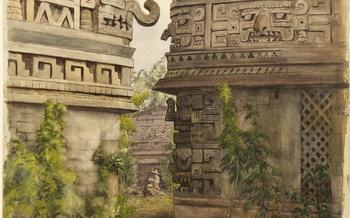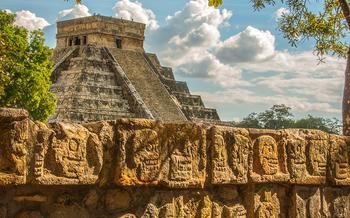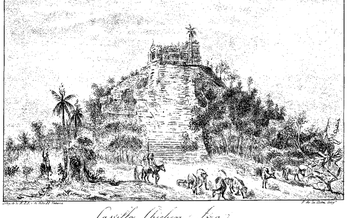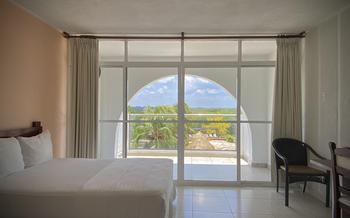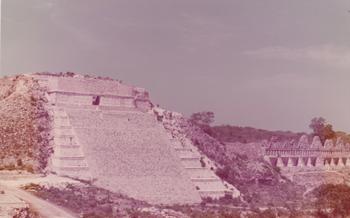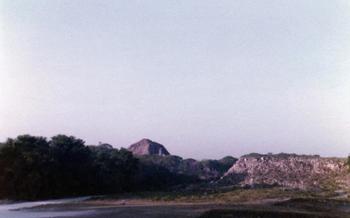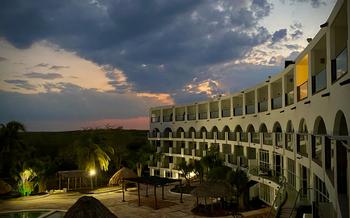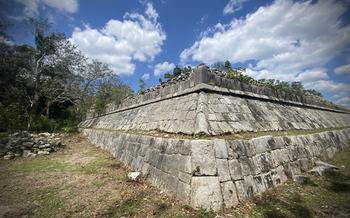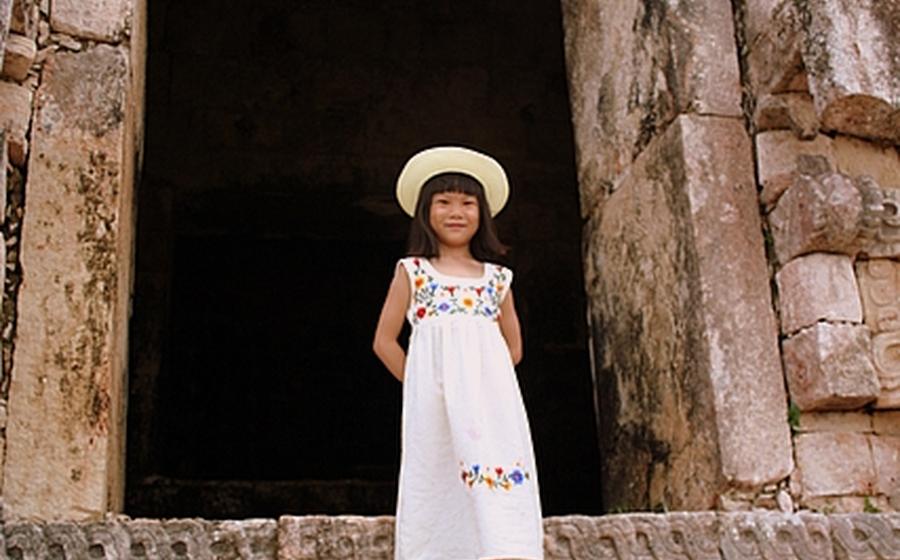
Kabah Archaeological Site
- Kabah Archaeological Site: Gateway to the Ancient Puuc Region
- Exploring Kabah: A Journey Through Time
- The Palace of the Masks: A Masterpiece of Mayan Art
- Temple of the Columns: A testament to Mayan Engineering
- Codz Poop: A Mysterious Structure with a Royal Connection
- Walking Trails and Exploration
- Photography Opportunities
- Local Culture and Cuisine
- Sustainability and Conservation Efforts
- Guided Tours
- Accommodations and Nearby Amenities
- Planning Your Visit
- Combining Kabah with Nearby Attractions
- Insider Tip: Uncovering Hidden Treasures
Kabah Archaeological Site: Gateway to the Ancient Puuc Region
Kabah, once a thriving city within the Puuc region of the ancient Maya civilization, stands as a testament to the region's architectural prowess and cultural significance. Located approximately 20 kilometers west of the more famous Uxmal, Kabah offers a unique glimpse into the lives and beliefs of the ancient Maya.
Its strategic location along ancient trade routes made Kabah a flourishing commercial center, and the city's monumental architecture reflects its wealth and power. Despite its proximity to Uxmal, Kabah retains its own distinct character, with unique architectural features and a rich history waiting to be explored.
Exploring Kabah: A Journey Through Time
Venturing into the Kabah Archaeological Site is like embarking on a journey through time, where the echoes of ancient civilizations reverberate through every structure and artifact. The site boasts an array of architectural marvels, each showcasing the ingenuity and artistry of the Maya people.
Among the highlights are the Codz Poop, a mysterious structure with a pyramidal base and rounded corners; the Palace of the Masks, renowned for its elaborate facade adorned with sculpted masks; and the Temple of the Columns, a testament to Mayan engineering prowess with its colonnades and towering roof combs.
Unique features abound at Kabah, captivating visitors with their intricate details and profound symbolism. The site is adorned with masks, bas-reliefs, and glyphs, each narrating a chapter in the history and mythology of the ancient Maya. These elements not only enhance the visual appeal of the site but also provide valuable insights into the lives and beliefs of its former inhabitants.
The Palace of the Masks: A Masterpiece of Mayan Art
The Palace of the Masks is undoubtedly the most iconic structure at Kabah. Its facade is adorned with over 200 sculpted masks, each with distinct features and expressions. These masks are believed to represent various Mayan deities, ancestors, or rulers, and are a testament to the exceptional artistry and craftsmanship of the ancient Maya.
Some scholars suggest that the masks served as a form of protection, guarding the entrance to the palace and its inhabitants from evil spirits. Others believe that they may have had a more symbolic meaning, representing the many faces of the Mayan gods or the diversity of the Mayan people.
Regardless of their exact significance, the Palace of the Masks remains a captivating sight that leaves visitors in awe of the creativity and skill of the ancient Maya. It is a must-see for anyone interested in Mayan culture and history.
Temple of the Columns: A testament to Mayan Engineering
The Temple of the Columns at Kabah stands as a testament to the architectural prowess and astronomical knowledge of the ancient Mayans. Its most striking feature is the impressive colonnade that gives the temple its name. The colonnade consists of two rows of massive stone columns, each intricately carved with geometric designs and adorned with glyphs. The columns support a roof comb, a distinctive feature of Mayan temples, which rises high above the structure, creating a dramatic silhouette against the sky.
The Temple of the Columns holds great historical significance as it is believed to have been constructed between the 7th and 10th centuries AD. It served as a religious and ceremonial center for the ancient Puuc Maya and was dedicated to the worship of the rain god, Chaac. The temple's alignment with the cardinal directions and celestial events further demonstrates the Mayans' advanced understanding of astronomy.
Beyond its religious significance, the Temple of the Columns is also a marvel of engineering. The Mayans constructed the temple using massive stone blocks, which were carefully quarried, transported, and assembled without the use of modern tools or machinery. The temple's remarkable stability and resilience are a testament to the ingenuity and craftsmanship of the ancient Maya builders.
The Temple of the Columns is not only an architectural wonder but also a symbol of the rich cultural and religious heritage of the Maya civilization. Its intricate carvings, symbolic motifs, and astronomical significance provide valuable insights into the beliefs, practices, and worldview of this ancient Mesoamerican civilization.
Codz Poop: A Mysterious Structure with a Royal Connection
The enigmatic Codz Poop stands as one of the most intriguing structures within the Kabah Archaeological Site. Its commanding presence and unique architectural features have captivated the imaginations of archaeologists and visitors alike. Rising from a solid, pyramidal base, the Codz Poop exhibits a striking silhouette, distinguished by its rounded corners, a distinctive attribute that sets it apart from other Mayan constructions.
The exact purpose of this enigmatic edifice remains shrouded in mystery, with scholars proposing various theories. Some suggest that it served as a temple, a place of worship and spiritual ceremonies, its sacred chambers echoing with the prayers and rituals of the ancient Maya. Others contend that it functioned as a royal palace, a majestic residence for the city's elite, its grand halls resonating with the echoes of power and authority. Yet another theory posits that the Codz Poop played a central role in ceremonial gatherings and public events, its spacious courtyards and elevated platforms serving as stages for vibrant performances, celebrations, and processions.
Intricate symbolism and ornamentation adorn the Codz Poop, providing tantalizing clues to its significance. Glyphs and carvings, etched into the stone with meticulous precision, depict scenes of everyday life, mythological narratives, and historical events, offering a glimpse into the rich tapestry of Mayan culture. These intricate embellishments serve as a testament to the artistry and craftsmanship of the ancient Maya, transforming the Codz Poop into a canvas of sacred stories and symbolic expressions.
Walking Trails and Exploration
Kabah offers a network of well-maintained trails that invite visitors to explore the site at their own pace. These trails wind through the ruins, revealing hidden corners and offering unique perspectives of the ancient city. Whether you are passionate about history, architecture, or simply enjoy immersing yourself in nature, there is a route that caters to your interests.
For those seeking a comprehensive exploration, the Grand Circuit trail is a must-do. This 2-kilometer loop takes you past all the major structures, including the Palace of the Masks, the Temple of the Columns, and Codz Poop. As you follow the path, you will encounter informative signs that provide insights into the history and significance of each building.
If you are short on time or prefer a more focused experience, opt for one of the shorter trails. The Palace of the Masks trail offers a closer look at this architectural masterpiece, while the Temple of the Columns trail highlights the impressive engineering feats of the Maya.
Regardless of the trail you choose, be sure to wear comfortable shoes and bring plenty of water, especially during the hot summer months. The sun can be intense, so sunscreen and a hat are also recommended.
As you navigate the trails, keep an eye out for wildlife. Kabah is home to a variety of birds, reptiles, and insects, which often make an appearance along the paths.
Finally, respect the site and its surroundings. Stay on the designated trails, avoid climbing on the structures, and refrain from touching or removing any artifacts. Your cooperation helps preserve this precious cultural heritage for generations to come.
Photography Opportunities
Kabah is a photographer's paradise, offering a plethora of stunning backdrops to capture the essence of this ancient Mayan city. The best time to take photos is during the golden hour, just after sunrise or before sunset, when the warm, diffused light casts a magical glow on the ruins.
To capture the grandeur of Kabah's architecture, use a wide-angle lens to encompass the towering structures and intricate details. For close-up shots of the intricate carvings and bas-reliefs, a macro lens is ideal. Experiment with different angles and perspectives to create dynamic compositions.
Remember to respect the site's regulations and avoid using tripods or flash photography, as they can damage the fragile ruins. Instead, use a sturdy monopod or handheld shooting techniques to minimize camera shake and ensure sharp images.
Share your Kabah photography with the world by posting your best shots on social media using relevant hashtags. Inspire others to explore this hidden gem and showcase the beauty and significance of this ancient Mayan city.
Local Culture and Cuisine
Beyond the archaeological wonders of Kabah, the region is a treasure trove of local culture and cuisine. Take some time to explore the nearby towns or villages, where you'll find authentic experiences that will enrich your understanding of the Yucatan. Visit local markets to savor the flavors of traditional food and browse colorful handicrafts. Don't miss the opportunity to try regional delicacies like Poc Chuc, a grilled pork dish, or Cochinita Pibil, a slow-roasted pork dish cooked in banana leaves. For a taste of local street food, indulge in Panuchos, fried tortillas filled with black beans and topped with shredded turkey, pickled red onions, and avocado. Immerse yourself in the vibrant cultural events and festivals that celebrate the region's rich heritage, showcasing traditional music, dance, and art.
Sustainability and Conservation Efforts
Kabah, like many other ancient Mayan sites, faces the challenges of preservation and conservation. Responsible tourism plays a crucial role in ensuring the longevity of this cultural heritage. Here are some sustainability and conservation efforts to keep in mind when visiting Kabah:
- Respect the Local Environment: Avoid littering, picking plants, or damaging the natural surroundings.
- Cultural Heritage Preservation: Refrain from touching or climbing on the structures to prevent erosion and damage.
- Waste Management: Dispose of waste properly in designated bins to minimize environmental impact.
- Water Conservation: Be mindful of water usage, especially in arid regions, by taking shorter showers and conserving water.
- Sustainable Practices: Support local initiatives that promote sustainable practices, such as using solar energy or recycling programs.
- Education and Awareness: Spread awareness about the importance of preserving cultural and natural heritage by sharing your experiences and encouraging others to visit responsibly.
Guided Tours
Enrich your Kabah experience by exploring with a knowledgeable guide. They will bring the ancient history and culture to life, highlighting details and stories you might miss on your own. Look for reputable tour operators that offer various options to suit different interests and budgets. Choose a guide who is passionate about Mayan history and can provide insights into the symbolism and significance of the site. Guided tours often include transportation from nearby towns and hotels, making it a convenient and hassle-free way to visit Kabah. Remember to book your tour in advance, especially during peak tourist season, to secure your spot.
Accommodations and Nearby Amenities
Accommodations:
-
Hotels: For a comfortable stay with modern amenities, consider hotels like Hacienda Uxmal or Hotel Uxmal.
-
Guesthouses: For a more budget-friendly option with a local touch, guesthouses like Casa Blanca or Posada Uxmal offer cozy accommodations.
-
Hostels: For backpackers and budget travelers, hostels like La Casa del Jaguar or Hostel Uxmal provide affordable dorm rooms and a social atmosphere.
Restaurants:
-
Local Cuisine: For authentic Yucatecan flavors, try restaurants like El Mesón del Marqués or La Cocina de Mama for traditional dishes like Poc Chuc and Cochinita Pibil.
-
International Cuisine: For a wider variety of dining options, explore restaurants like The Lodge at Uxmal or The Restaurant at Hacienda Uxmal for international cuisine and fine dining experiences.
Transportation:
-
Car Rental: Renting a car is the most convenient option for exploring the region at your own pace. Several car rental agencies are available at the Mérida International Airport.
-
Guided Tours: Many tour operators offer day trips or multi-day packages that include transportation from major cities like Mérida or Cancún.
-
Public Transportation: Buses and colectivos (shared vans) are available for budget travelers, but schedules may be limited and less convenient.
Suggested Itineraries:
-
1-Day Itinerary: Combine a visit to Kabah with a tour of the nearby Uxmal ruins. Start early to beat the crowds and heat, and spend the afternoon exploring the impressive structures of both sites.
-
2-Day Itinerary: Add a visit to the Loltún Caves, a stunning underground cave system located about an hour from Kabah. Explore the caves, take a refreshing dip in the cenotes, and learn about the region's unique geology.
-
3-Day Itinerary: Extend your stay and visit the ancient city of Chichen Itza, one of the New 7 Wonders of the World. Witness the iconic pyramid of El Castillo, climb the Temple of Kukulcan, and immerse yourself in the rich history of the Maya civilization.
Planning Your Visit
Venturing into Kabah requires some essential preparations to ensure a comfortable and enjoyable experience. Begin by packing comfortable shoes, as you'll be doing plenty of walking on uneven terrain. Remember to bring a reusable water bottle to stay hydrated under the scorching Yucatan sun. Sunscreen and a hat are non-negotiable to protect your skin from the intense UV rays.
Dress appropriately for the tropical climate with lightweight, breathable clothing that covers your shoulders and knees. Avoid wearing revealing or sheer garments as they may be considered disrespectful at historical sites. It's also advisable to carry a small backpack or bag to keep your essentials organized and within reach.
Before setting out, ensure you have a fully charged camera or smartphone to capture the site's captivating beauty. A pair of binoculars can enhance your exploration, allowing you to observe intricate details from a distance. Finally, consider bringing a notebook and pen to jot down your observations, thoughts, and reflections as you wander through this ancient city.
Combining Kabah with Nearby Attractions
Kabah stands as a remarkable gem among a constellation of ancient cities and natural wonders that adorn the Yucatan Peninsula. To fully immerse yourself in the region's rich cultural and environmental tapestry, consider venturing beyond Kabah's boundaries and exploring the wealth of attractions that lie within easy reach.
Uxmal, a UNESCO World Heritage Site, beckons with its awe-inspiring pyramids, intricate sculptures, and the iconic Governor's Palace. Chichen Itza, another UNESCO marvel, boasts the towering El Castillo pyramid, the Great Ball Court, and the sacred cenote. For a more intimate encounter with Mayan history, Ek Balam offers a serene setting amidst lush jungles, where you can climb the Acropolis and admire the well-preserved stucco masks and carvings.
Yucatan's natural wonders are equally captivating. Dive into the crystalline waters of cenotes, natural sinkholes that provide a refreshing respite from the tropical heat. Explore the labyrinthine caves, adorned with stalactites and stalagmites, and immerse yourself in the subterranean beauty of the region. For a unique wildlife experience, visit the biosphere reserves, home to diverse flora and fauna, including flamingos, crocodiles, and howler monkeys.
Beyond ancient ruins and natural wonders, the Yucatan Peninsula is home to vibrant colonial cities and towns. Mérida, the region's capital, offers a delightful blend of colonial architecture, Mayan culture, and modern amenities. Explore its historic center, visit the impressive cathedral, and savor the flavors of Yucatecan cuisine. Valladolid and Campeche are other colonial gems, each with unique charm and attractions, such as the Convent of San Bernardino de Siena and the Campeche Fortifications.
To create a customized itinerary that suits your interests and time constraints, consider combining Kabah with other nearby attractions. Whether you seek cultural immersion, adventure, or a blend of both, the Yucatan Peninsula offers endless possibilities for exploration.
Insider Tip: Uncovering Hidden Treasures
Venture beyond the main tourist paths to uncover the hidden treasures of Kabah. Explore the lesser-known areas of the site, where you might stumble upon secluded structures, intricate carvings, and ancient inscriptions that have yet to be fully deciphered. Keep an eye out for hidden chambers, passageways, and architectural details that reveal the ingenuity and artistry of the ancient Maya.
Engage with local experts, archaeologists, and guides who can provide insights into the ongoing research and discoveries at Kabah. They can share their knowledge about the site's history, symbolism, and cultural significance, helping you to appreciate its complexities and mysteries.
By exploring the hidden corners of Kabah and seeking out the untold stories that lie within its ruins, you'll gain a deeper understanding and appreciation for this ancient city and its enduring legacy.
